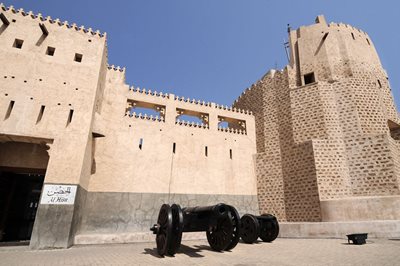

Sharjah Fort (Al Hisn) was first renovated and opened as a museum in 1997. It then underwent remarkable renovations and re-opened its doors in 2015.

Sharjah Fort offers you the opportunity to learn about the modern history of Sharjah, the ruling family, the history of the fort, the defense methods and Sharjah’s everyday life 200 years ago.
Explore one of the most important heritage buildings in Sharjah’s historyThis deep-rooted edifice, which was built in 1823, is located in the Heart of Sharjah; it was Sharjah’s government headquarter and the residence of Al Qawasim ruling family. The Fort is a square- shaped construction, featuring a spacious yard in the middle. It consists of two main floors and three towers built for defensive purposes. When first built in 1823, it was considered the biggest and most important construction in Sharjah.
The fort was built with coral stones which were collected from the deep sea waters of the Arabian Gulf. The walls were covered with a light brown plaster, and the doors were made of teak wood. Mangrove trunks and parts of palm trees (fronds, leaves and fibers) were used to build the ceilings.
The fort was built for defensive purposes, mainly to protect the city and its inhabitants. The main defensive elements included solid thick walls, high defensive walls and high watchtowers, along with many other defensive structures. The fort also served as the residence of the Qawasim ruling family, and was the headquarter of Sharjah government.
As you explore the rooms of the fort, you will come across a wide collection of photographs and archaeological artifacts. In Al Muhalwasa jail, you will learn about the first jurisdiction system adopted in Sharjah. You will also get the chance to find out how “dibs” (date molasses) was made in the past. Moreover, you will learn about the weapons and defense strategies used by the Sheikhs and their guards, as well as the lifestyle of the ruling family.
Highlights from the collection